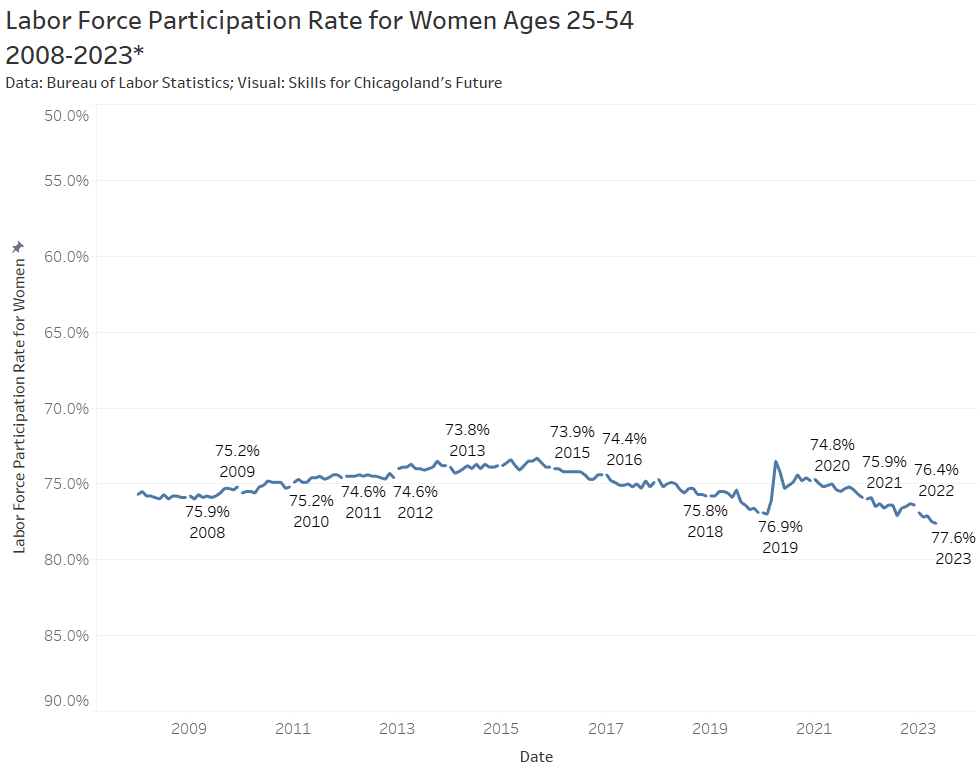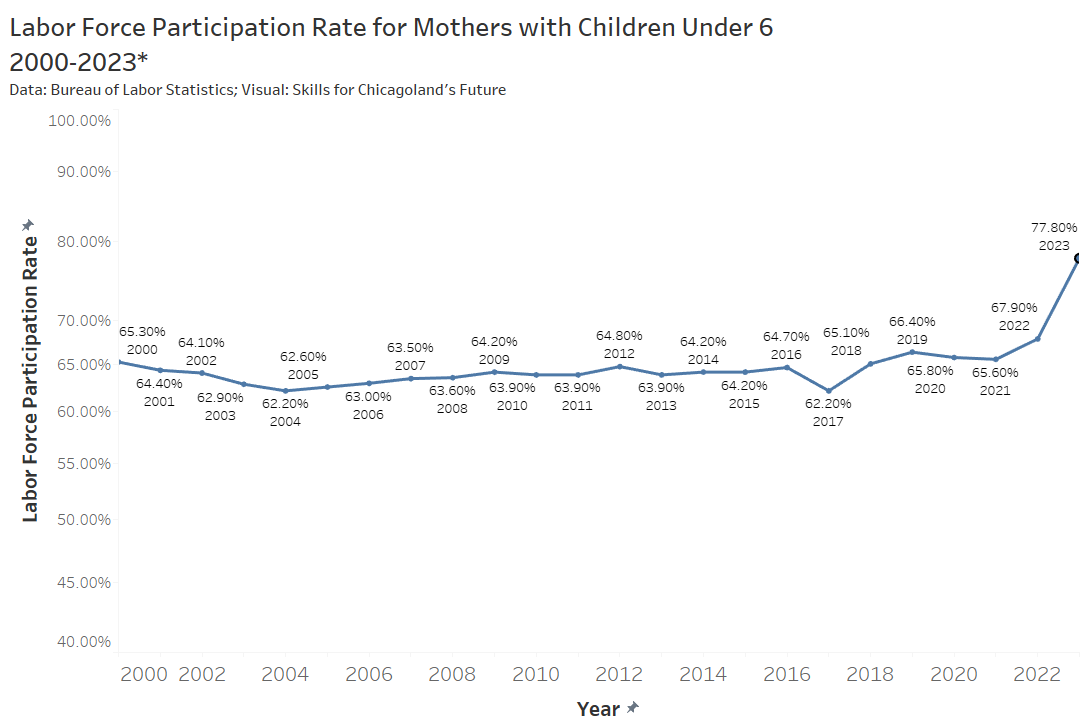The year 2023 has seen an increase in layoffs and a slowdown in overall hiring leaving Americans feeling less confident in the labor market than we have seen in recent years. During the post pandemic labor market we saw what was called “The Great Resignation”, as many people left their jobs for new opportunities. Recently, as the labor market continues to slow down, we have seen a shift in this behavior as employees are less likely to leave their current positions. This was proven in the last Job Openings and Labor Turnover report showing the lowest quit rates we have seen in the last two years. Additionally, we have seen an increase in the participation of women in the workforce; in May 2023, the labor force participation rate for women ages 25-54 was 77.6%, a full four percentage points higher than a decade ago and only 11.5 percentage points lower than men’s rate of 89.1%.
Although women are returning to the workforce faster than ever, we have noticed a discrepancy between the likelihood of women stay in their roles versus men. Using national data along with Skills data, we have found that in the shorter-term, women have a higher likelihood of staying at positions compared to their male counterparts, while in the longer-term men are more likely to stay at their jobs. We have studied several contributing factors impacting the difference in gender retention rates including: job tenure, maternity leave and what is known as the confidence gap. A hypothesized factor that did not lead to different retention rates was pay.
Graph A:

National Percent Distribution by Tenure with Current Employer by Age and Gender
Table A:
-1.png?width=1838&height=459&name=Screenshot%20(14)-1.png)
*January 2022
The U.S. Bureau of Labor Statistics has data on the percentage of men and women that stay at the same job for specific periods of time. As shown in Table A, the likelihood that men and women ages 20 and older stay at a job longer switches as tenure increases. For women, retention rates are higher when they have been working for 12 months or less, 13 to 23 months, and 2 years. Once 3 years or more is reached, each measured increment of time shows men are more likely to stay longer in their roles. The largest difference is found in 12 months or less at a job, where women are 2.7% more likely to stay than men.
Yet, as time spent at a job grows, data from the U.S. Bureau of Labor Statistics shows that more women than men fall out of the workforce, specifically in the age category of 25-44 years, an age range where over 90% of mothers have their children. According to the U.S. Census Bureau 2019 survey of income and program participation, only 66.5% of eligible fathers use parental leave compared to 96% of new mothers. This has led to women being seen as less committed to their jobs, less likely to be promoted into management positions or given pay raises once their leave is over, and more likely to be demoted or fired. This is especially seen with women who take longer maternity leaves. Therefore, retaining women in the months leading up to maternity leave, during the leave and shortly thereafter when returning to work have all been continuing issues in the U.S. workforce.
As the ability to work remotely has increased since the pandemic, we have seen a historic high in the labor force participation rate for women with children under 6, coming in at 70.4% in June of 2023. With the option to work remotely, women do not have to choose between taking off work during their first child and risking the effects of getting off track. Most women tend to feel behind after having children in terms of income, job selection, and promotions. Yet, working remotely allows women to balance work and family life without having to sacrifice one for the other.
Graph B:

Retention Rates by Gender and Wage Measured by Skills
Graph C:

Similar to national data, Skills’ data shows that when measuring short-term retention, females have higher tenure rates than their male counterparts. Skills measured the 30-day and 90-day retention rates of men and women in the same jobs along with wages and saw that women stay longer at their jobs even when the average wage for males is higher by 75 cents. When the retention for candidates is measured by 30 days, females have a retention rate of 82.1% while males have a 79.5% rate. The same trend is shown in Graph B when the retention for candidates is measured by 90 days. The orange circle represents females with a 60.2% retention rate and an average hourly wage of $16.45. The data for males is shown in the yellow circle with a 50.9% retention rate for an average hourly rate of $17.20. It is clear that female tenure is higher, and the male wage is up by 75 cents.
A theory that may explain similar trends for women’s retention rates in national and Skills data is known as the confidence gap. This phrase is explained by author Russ Harris in his book, “The Confidence Gap: A Guide to Overcoming Fear and Self-Doubt,” refers to women generally feeling a lack in self-confidence and competence compared to men, which lessens a woman’s perceived ability to negotiate salaries, advance professionally, assume leadership positions, and change jobs. In 2023, women make up almost half of the US workforce at about 47% and only about 32% of top executive roles. According to Goldman Sachs, companies employing women in large numbers outperform their competitors in profitability because competence in women is outstanding. However, most women are stuck in middle management positions because of the gap created between acting on new opportunities and feelings of confidence. Feeling confident is a necessary skill in the workforce especially for women that are early on in their careers. Studies of business-school students at Carnegie Mellon University show that men initiate salary negotiations four times as often as women do, and that when women do negotiate, they ask for 30 percent less money than men do. The same phenomenon may occur when women decide to change jobs yet may feel unqualified and lack the confidence to do so.
Next Steps
Although concerns such as work-life balance, maternity leave, and the confidence gap impact retention rates, a main driver that develops all of the listed factors is the work environment. A Harvard business review study explains that the environment of work is what really matters. The study listed the following as things that make a difference in retention rates: improving connectedness, using strengths-based development, and acknowledging a range of effective communication styles. For instance, when a woman is going on maternity leave, her company could either connect with specialists who can help on specific projects to fill leaves or develop a group of employees who could consult for a few months to cover the work.
According to the Maven Clinic, a digital support network for women, while 75% of new mothers claim to be eager to return to the workforce after giving birth, 57% actually do so. Replacing a worker who leaves their position after giving birth might cost anywhere from 20% to 213% of that person's annual salary. This makes three to four months of paid maternity leave more affordable to companies and will help retain more women within the age group of 25-44 for longer. Therefore, if companies review their maternity leave policies, guaranteeing that women don’t have to make the choice between motherhood and successful careers, not only would this be more beneficial for equality in the workplace, but it is also of economic value to the companies as it costs them more to re-hire than to provide a better maternity leave plan.
As Skills continues to investigate the continued discrepancies between men and women in the labor market, we have released a survey to job seekers who have recently left positions to better understand what led to this. This report is expected to be released at the end of 2023.



